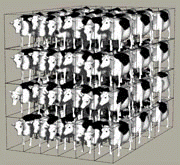Animal Science, Department of

World Congress on Genetics Applied to Livestock Production: 3rd (1986)
Date of this Version
1986
Abstract
Results are reviewed from the cattle Germ Plasm Evaluation Program at the Roman L. Hruska U.S. Meat Animal Research Center comparing performance of top-crosses by 20 sire breeds. The variation that exists in biological traits important for beef production is vast and under a high degree of genetic control. Significant genetic change can result from 1) selection among breeds, 2) use of crossbreeding to exploit heterosis and 3) selection within breeds. Estimates of the range for differences between breed means vary from 2.5 to 6.3 phenotypic standard deviations (σp) and exceed 4σp for most traits. The range for differences between breed means is the approximately equal to the expected range for breeding values of individuals within breeds (6σg) for most growth, carcass, puberty and maternal characteristics studied. Heterosis effects are important, but not nearly as large (<.5σp) as the range for additive genetic differences between breeds. Use of genetic diversity between and within breeds with 1) rotational crossbreeding, 2) rotational-terminal-sire crossbreeding systems and 3) composite populations to improve efficiency of beef production in temperate climatic zones is discussed.


Comments
Published in 3rd World Congress on Genetics Applied to Livestock Production, edited by Gordon E. Dickerson and Rodger K. Johnson, 4 vols. (Lincoln: University of Nebraska Institute of Agriculture and Natural Resources, 1986). Copyright © 1986 Board of Regents University of Nebraska.